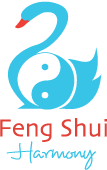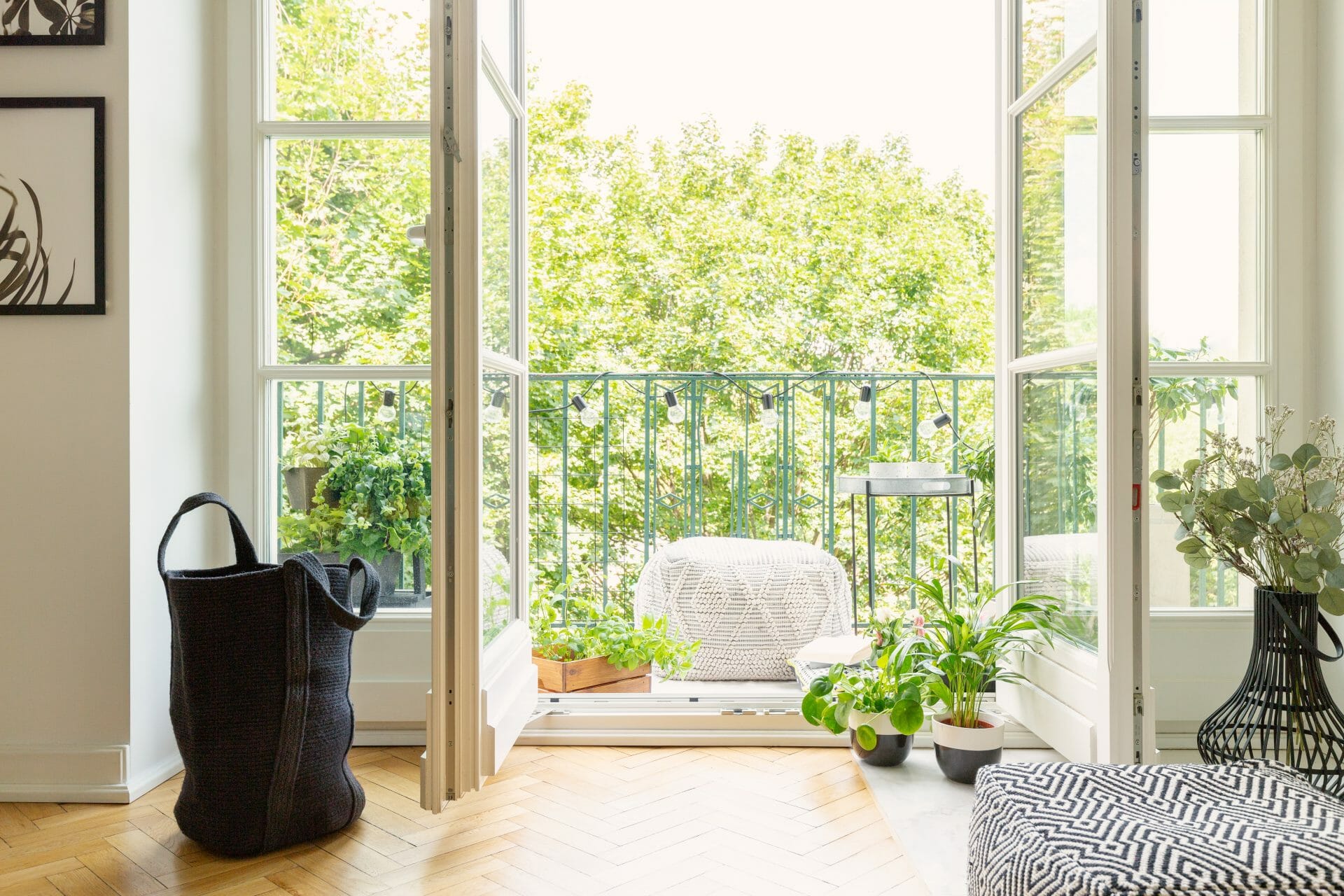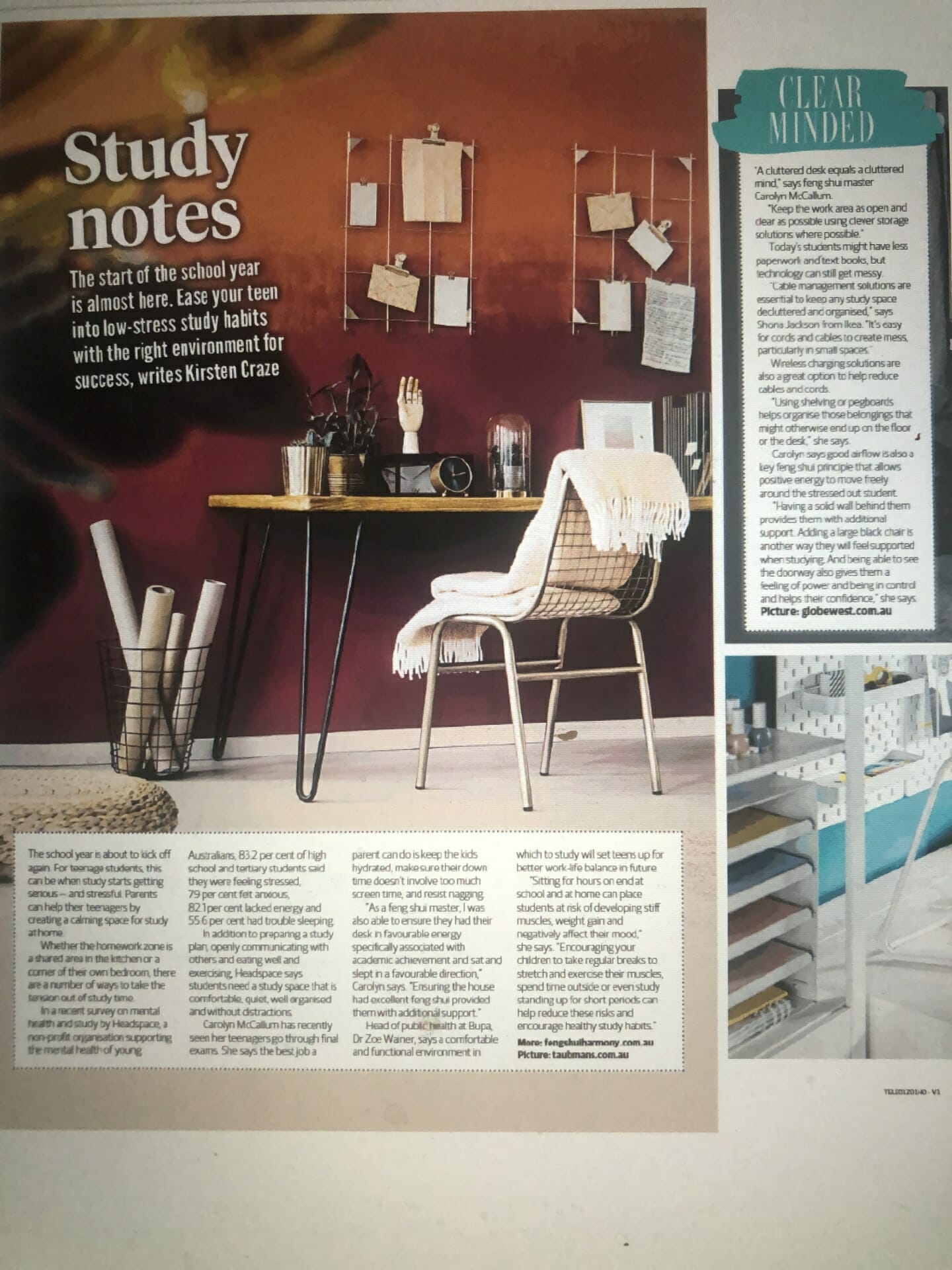I have just spent the last 6 days immersed in my favourite subject – Feng Shui. The first 4 days were a Master Class and the last 2 days was an Academic Symposium on Feng Shui. Taking 6 days out of my full time consultancy is a luxury and I have a lot of work to catch up on as a result. Before ploughing head first into that mountain of work I wanted to give myself some time to reflect on the experiences, integrate these learning’s into my business processes and Feng Shui practice and provide an insight to others who weren’t able to attend. From Tuesday to Thursday I listened to the passionate Howard Choy who I have studied with a few times over the last 5 years. His practical application of Feng Shui is always so helpful in my everyday practice and enables me to understand this subject in a way that I can apply to get solutions for both my business and residential clients. The title of this Master Feng Shui Course was; Feng Shui for the Asian Market: How to Achieve auspicious Form and avoid taboos for Asian Clients. We focussed on the importance of Form around a building from both a macro (exterior) and micro (interior) level. We looked at specific techniques using Flying Star School and Eight Mansions. I have learnt about the importance of Form since my initial Feng Shui study in 2004 with the wonderful Melynda Munroe. I have shared some gems with you in this blog that resonated with me during the week.
It is always good to revisit this important aspect and ensure I integrate it within every consultation I do. Basically, you can have the perfect interior arrangement in terms of Feng Shui in your home or business but if the forms around the building are not supportive, then all the interior aspects will not work in an effective way. The yin and yang balance within a home generally and rooms specifically cannot be underestimated. Forms never lie but formulas are not always correct.
In recent years I have been doing more hotel, Club and medium to large-scale residential developments like apartment complexes and the like. More often than not, part of the brief is to ensure the property will be attractive to the Asian market. Most Feng Shui practitioners try to distance themselves from the superstitious aspects related to Feng Shui, however as I have an online shop selling a lot of cures (www. everythingfengshui.com.au) I have always been open to this component which does play a part in implementing Feng Shui especially for my Asian clients. Power does not come from the object itself. Power comes from the meaning you give the object.
Not being Asian myself, I have not been as aware of all the superstitions and taboos which form part of this culture and these are often not taught within the Traditional studies I have completed to date so I have only been able to pick up bits and pieces along the way. Howard spent time going through these superstitions and taboos and by doing that has allowed me to better understand the needs of my Asian clients in particular. He taught me that it is irrelevant whether I believe in ghosts and spirits and the effectiveness of cures or talismans. As a Feng Shui practitioner, I need to put the needs of my client first and really listen to their fears and aspirations and use my skills and expertise to assist them in their journey of achieving optimal health, great relationships and their desired levels of wealth. The belief system of your client and the correlative thinking that comes with it is integral in servicing the clients needs. Where the mind goes, the Qi will follow.
Looking at the Qi flow in a building and how the doors connect up to provide an internal Dragon spine and identifying the heart of each room to locate the lounges, desks and beds is a way internal form can be achieved well. The location of doors is so critical as they are mouths where Qi flows. When designing homes I always incorporate a number of formulas to ensure the doors are located in the best position possible that also takes into consideration the practical needs of the clients. I use Form, Flying Star, 8 Mansions and Da Gua formulas and analyse Qi Flow to determine this. How to deal with various Sha’s (both internal and external) using both physical and metaphysical solutions was a practical way of solving specific issues. Focus on being practical and effective in Feng Shui consultations but also connect with the emotional and spiritual aspects inherent in the client you are working with.
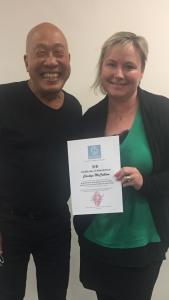
On Friday, I had the privilege of going on a tour with Howard visiting 3 sites that he has worked on in the past. We walked down Dixon Street looking at Chinatown and Howard explained the importance of the North – South connection and how it was integral to tap into the Qi flow of that as well as the thought behind the lighting with the Yin and Yang Yao lines that help to slow the Qi down. We also talked about the theory behind the famous Heaven connecting with Earth sculpture in the centre of Chinatown (see picture).
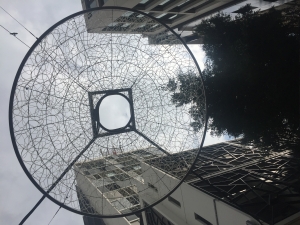
Next stop was the magical Chinese Gardens of Friendship. It was so lovely to visit here with my Feng Shui friends as well. Being a full time Feng Shui consultant is quite lonely as you work by yourself and tend to figure things out by yourself using your notes and textbooks. There are internet forums available but all in all, it is the only thing I miss about leaving my stable Government job in 2011 to do this full time. Working as part of a team (even though I was bored doing what I did) was enjoyable. Now I am doing something I love on a daily basis but I do miss the social connectivity of working closely with a group of people. After spending 6 days with my Feng Shui friends, my soul feels replenished and I am already looking forward to the next gathering in June at the Gold Coast for the Association of Feng Shui Consultant’s Conference where I am speaking about; Business Management and your Feng Shui Practice. But I digress, back to the gardens.
It is hard to believe that these are situated within the Sydney CBD. It is like entering another world, another time, you can breathe in the magic of the place. The Qi is moving and supportive and every turn brings you another spectacular view. Howard had worked out that the original design was based on the Early and Later Heaven Bagua and used water and compass methods. The trees became problematic as they blocked the view of the pagoda (host) which was integral in the design. Howard provided advice to prune back the gardens (guest) so the Qi could flow more effectively and the balance between yin and yang could be achieved. The importance of host and guest cannot be underestimated in good Feng Shui design.

Our final stop was Star City Casino. I have worked on over 10 Gaming areas for Clubs in NSW and ACT. One of the most important aspects is to ensure the patrons are as comfortable as possible and Star City definitely achieves that. It is well designed and access to toilets, fresh air and food is an integral part of keeping the gamer in the premises for a longer period of time. Specific placement of water features to activate wealth and the facing direction of the Casino were kept in mind during the architectural design process. The metal element used at the front of the building helps to support the water physically located here and pulls the wealth Qi into the premises.
The weekend brought the Academic Journal of Feng Shui’s 1st Symposium held at the University of Technology. The premise of this organisation is to study conventional Feng Shui laws and rules in a scientific, logical and consistent way. The theme was Canopy and Chariot – Chinese concepts of Heaven and Earth in the Feng Shui tradition. There were 2 Keynotes and 15 guest speakers over 2 days. I felt right at home as I spent 6 years at the University of Sydney completing my Bachelor of Education and Masters of Education in the early 1990s. Being around these Academics felt strangely comforting to me. I was so happy to be integrating my passion for learning and Feng Shui with the rigours of Academic focus and thoroughly enjoyed listening to a wide range of speakers talk about my favourite subject from different perspectives. I can’t give justice to the content of all the presentations but I have provided a brief overview of my understanding of what each presenter was trying to get across to the audience. My apologies to any of the presenters who I may have misunderstood and not adequately represented below. More information can be found at; www.AJoFengShui.co.nf
Christopher Zaslawski gave the Opening address from the Chinese Medicine Faculty of UTS. He talked about the obvious correlation between Feng Shui and Chinese Medicine with similar concepts of yin and yang and that both disciplines had a focus of improving health of clients. I learnt that many acupuncture sites have similar names to geographical descriptions used in Feng Shui. He gave the correlation of Chinese Medicine is Feng Shui for the body.
Keynote speaker, Hong-Key Yoon from University of Auckland spoke on A reflection on the academic scope of research into Chinese Geomancy. The similarities between the Maori culture and Feng Shui with focus on the importance of mountains and water and the relationships of humans with their environment was discussed. He divided his talk into three sections. Firstly, a review of what should be defined as Feng Shui, secondly, what is a suitable term for Feng Shui in English and thirdly, what are important Academic topics. He went on to say that Chinese geomancy or Feng Shui is an academic subject that has great research potential. He explained Feng Shui as being a traditional Chinese system of devising auspicious locations and placing suitable structures on them. Geomancy is an English term describing Feng Shui also called Chinese Geomancy. Apparently the use of the term Feng Shui has increased dramatically whilst the use of the term Geomancy has sharply declined. Hong-Key would prefer the use of the term Geomancy instead of Feng Shui and explained a number of reasons why he thought this would be better. He advised future research was needed specifically on the translation of the Ancient texts into English, documentation and interpretation of the practice of geomancy in different regions, research origins and dispersal of geomancy and finally to explore the important ecological principles as they are imbedded in the geomantic principles.
Jodi Brunner from the Feng Shui Research Centre, Australia presented on Defusing the North-South issue. The majority of practitioners do not change calculations for the Southern Hemisphere. I have been taught by over 10 Masters and Grand Masters and none of them have ever advocated changing calculations when assessing buildings in the Southern Hemisphere. I found this presentation beneficial as just because I know this should not be done, it was interesting to hear in detail the reasons why. Jodi suggested that proponents of Southern Hemisphere flippers (my term) look at tangible aspects of Feng Shui like sunlight from the North instead of the South and the fact that weather and seasons are opposite. She argued that Feng Shui is not based on the position of the sun or weather, rather it is based on Yin and Yang principles and intangible elements like the Lo Shu, Bagua, 5 element theory, Trigrams and Hexagrams. Qi is an abstract form that has its own life force energy. Feng Shui uses formulas to calculate how the Qi comes into a site which is why there is no need to change anything when assessing the Feng Shui of a site in the Southern hemisphere.
Howard Choy from the European College of Feng Shui spoke about The use and abuse of Chinese correlative thinking in Feng Shui. I have heard Howard talk about this previously but I always enjoy the passion behind his presentations and the fact that at his age and with his experience he is not shy in expressing his views. I love that he says what he thinks and he is the most Australian Chinese person I have ever met with a great affection for his homeland despite now living in Berlin, Germany. I fondly remember one of the first courses I did with him on Business Feng Shui where he described himself as a banana – he was yellow on the outside and white on the inside. Although probably not politically correct to discuss one’s skin colour in this way, I really loved the analogy especially when he described the Westerners in his class as eggs. We are white on the outside and yellow on the inside. I love being an egg and I have a real affinity with the Chinese way of life and obviously the practice of Feng Shui.
He talked about the fact that in Feng Shui there are two minds of thinking – the tangible and physical form school and the intangible, correlative and metaphysical schools like Compass school. Causal thinking reduces options to find the cause whereas correlative thinking increases options to find the cause. A Feng Shui consultation needs to be practically efficient and ritually correct. Solutions can be arrived at by balancing the Yin and Yang of the space.
Yan Ding from the National University of Singapore is a PhD student. Self-care landscapes: Feng Shui craft and everyday practices. She talked about the changes being made in Urban China and how Feng Shui is regaining popularity especially around Real Estate. She talked about the use of Feng Shui artefacts like coins and bagua mirrors having metaphysical connotations. Using cures shifts hopes and offers concrete procedures to follow to help empower our life.
Wei Dong from the University of Wisconsin-Madison presented on; Integrating Feng Shui concepts into painting creations. To be honest this was the presentation I was looking forward to least. As usual, when you have low expectations, you are at times blown out of the water. The vital life force energy that this man had in his presentation was palpable. He presented such an interesting concept of yin and yang in his artwork and the passion he had for integrating Feng Shui into his pieces was evident. There are cross-cultural links evident between Green design and Feng Shui.
Wan Thing Hong from Heriot-Watt University, Malaysia presented on; Are bedroom Feng Shui rules practical from the architectural perspective? She conducted a study by interviewing 16 architects to see if they complied with classical feng shui bedroom rules. These rules include being primarily yin, having the bed against a solid wall and furthest away from the door whilst still being able to see the door. The architects were asked to place a bed, vanity and wardrobe in a room. The conclusion was that the majority of architects follow best practice Feng Shui design without realising that they are doing this. Using Feng Shui is often quite a logical way of arranging furniture in a room.
Xing Lan from Macquarie University presented on the Traditional application of five phases in Feng Shui: an examination of the Golden Mirror to Peaceful Dwellings. Every dwelling has an overall element attached to it based on its structure. The application of the 5 phases can be traced back to the 1st century. Examples were provided about external layout, internal structure and the surrounds of a dwelling based on the Kanyu Golden Casket written by Ban Gu (32-92).
Michael Mak from the University of Newcastle presented an Empirical Study of modern sustainable office buildings in Sydney from the Feng Shui perspective. Sustainability is a new concept but there is lots of common ground relating to what Feng Shui does. Green building design is interested in increasing efficiency, reducing building impacts and sustainable development and it can be argued that Feng Shui operates in a similar way. Michael examined three buildings rated 6 stars for Green Buildings in Australia. These were the Workplace6 at Pyrmont, Commonwealth Bank Place and 1 Bligh St. All three have an open central atrium similar to the principles of a Chinese courtyard home. He visited 31 different 4, 5 and 6 green star rated buildings in Sydney and correlated their designs with common Feng Shui principles using a Form School approach and found that these buildings followed Feng Shui design principles showing a correlation between Green Design and Feng Shui.
Michael Paton from the University of Sydney spoke about The Dragon(s) of Sydney. Being a local, I found this quite fascinating as I get to work with the energy of these Dragon veins on a daily basis. 80% of the population of Australia live between the Great dividing Range and the East coast of Australia – they are literally living off the energy of the Dragon vein. This is where the land is most fertile and supportive. A water dragon needs a trunk and branches to gather energy. Reclaiming land is not good. Interestingly Sydney has a Dragon line going directly from Governor House to Circular quay. There is also a burial line over Rookwood Cemetery. Unfortunately railway lines cut the dragon flow of Qi. The soil and water of a place gives birth to a people of that place.
Mauro Rahardjo of Parahyangan Catholic University , Bandung, Indonesia talked about Feng Shui as design paradigm in architecture. He designed his first building based on Feng Shui principles as an architect in 1983. He focuses on the clients needs when designing especially in terms of their health. Looking at their Bazi chart will show areas of weakness in their health that can be counteracted in the design of the particular house based on what element they need for support. He discussed architecture in terms of Geometry, Technology, Social Phenomena, Ecology and Culture.
The final presentation for Saturday was from Boon Yap from Feng Shui for Enriching Lives. She spoke passionately about Is Feng Shui a Science? I enjoyed her presentation as she questioned the need for fitting the metaphysical practice of Feng Shui into the field of Science. Why do we need to justify or legitimise this practice in terms of Science? Science gives a topic reliability but do we have to play the game and answer questions to give Feng Shui the recognition it deserves? Why is it put under so much scrutiny? Why doesn’t the subject of Philosophy get scrutinised as much? In Chinese culture, there is no need for science as Feng Shui is part of a lineage system. It seems a lot of ethnic traditions are questioned in the West. She defined science as a method rather than a faith and argued that Feng Shui is a science as it is a systematic organised body of knowledge. She advised on where we go from here and talked about the sad demise of Feng Shui which has gone from classical to pop. We must remember that if done badly, Feng Shui can cause harm. Energy is easily upset if a water feature is put in the wrong place. She ended by stating that unless you put the rigour into your practice you don’t know what is working and what is not.
Sunday commenced with a Keynote presentation by Derham Groves from the University of Melbourne on Feng Shui: Intuition: not just superstition. Architecture: superstition not just intuition. In direct opposition to the last speaker of the previous day, Derham started by saying Feng Shui and Architecture are not a science. There are other ways to have it accepted. We don’t need science to validate Feng Shui. Many people struggle to explain this field. Is it a thing, or a phenomenon. Some believe Feng Shui based on the classics with formulas etc is real but using talismans and cures is not real Feng Shui. There is so much disagreement within our field it is hard to define Feng Shui. He maintains that the superstition aspect should not be dismissed. Feng Shui and architecture are related. They are about good sites for burial and houses. He suggests putting Feng Shui through an architectural prism as a great way to explain it rather than trying to prove it is a science.
The illogical and superstitious side to Feng Shui is important to acknowledge because that is what the general population identify with. Form school seems to align the best with most architectural approaches. Feng Shui is based on centuries observing the environment. It is empirical data. The importance about the superstitious aspects is these can be used when a problem is evident, it is interpreted and then a symbol or items are introduced to trump it. This provides great relief to the client you are helping. Feng Shui has been practiced in Australia since 1851 when the Chinese came to the Goldfields. Looking at buildings built for Chinese then and now gives us an insight into Feng Shui practices. You can see that whenever there is a choice, buildings face water. Topography of the land always trumps direction or orientation of a building. Simple buildings often have complex symbolism built into them. If you look at an aerial view of the Forbidden City in China, it looks like a large bow and arrow. We should think about Feng Shui and Architecture together.
I was delighted to hear the next speaker, Grand Master Stephen Skinner, International Feng Shui Association, Singapore, who I have studied with on numerous occasions. He always speaks so authentically and you know that a lot of thought, checking and research has gone into anything he says. His discussions always resonate with me and provide such important points that I can use in my daily practice. When I was in China a few years ago he went into more detail about why we should be using the 9-palace method rather than the pie method for internal analysis of a building using Flying Stars. I had heard him speak about this previously but I wasn’t ready to adapt it into my practice. Since China, I have been using it more often, especially with long, rectangular buildings like those terraces found in Paddington and Surry Hills (where only the facing, central and sitting palaces are used). I have had great results doing this. It has also really stepped up my understanding of Qi flow within a building and helped my building designs for clients as well. Whilst I enjoyed all the presentations, this was my favourite as it really clarified a lot of my learning and understanding to date and dealt with the confusion I had been having regarding all the methods I use when consulting and the difficulty I have had when some formulas and schools clash.
The presentation was titled; The use of different metrics or Feng Shui formula for different parts of the built environment. Which formulas should be used to implement Feng Shui. External Feng Shui is most powerful whilst internal Feng Shui is easily changeable. Stephen’s premise was that formulas can be divided into different zones. If you match the appropriate formula to the appropriate zone then it works. There is never any conflict between different schools when using this method. Mismatching zones is never going to end well. For instance if using Flying Stars and Eight Mansions, you sometimes get situations where the Flying Star school say a particular room is great whereas the Eight Mansions school says the same room is terrible. This was truly music to my ears!!! An excellent point is that Eight Mansions should be used for door placement within the building and sitting and sleeping directions of occupants whereas flying star methods should be used to determine the distribution of energy within a room. Additionally, using the pie wedge method externally and the 9 palaces method for the interior is essential as is using the birthdate of a building as being the same as its construction date (there are some exceptions to this). Stephen is adamant that the birthdate of a building should not be worked out based on the when the occupants move into the building.
Rey Tiguia, University of Melbourne spoke about; Surfing the oceanic waves of the cosmic breath under the guidance of the stems and branches calendrical clock. He talked about the importance of Qi and translating it into Cosmic Breath. There is a specific link to acupuncture points.
Jing Wei from University of Wisconsin-Madison spoke about Decoding ancient Feng Shui talismans.
She provided interesting examples of talismans used to provide good luck and prevent misfortune. These were used to fix sha’s and guard houses. They were usually put on the front door for protection. They were also used for healing and exorcising ghosts as well. They often had a specific function and could be put in a specific location, carried on the body and even swallowed after burning – Yuk! It is good to research social and cultural reasons for contemporary solutions to Feng Shui problems.
Wing-Fai Wong from the University of Queensland spoke on; Five emperor coins: the transformation of Yansheng objects as popular culture in Feng Shui. The five coins on a string are often used as a cure in Feng Shui. The round coin represents heaven and the square centre represents earth. This remedy is often used to stabilise health in Feng Shui.
The final presentation of the Symposium was by the organiser, Tyler Rowe, Institute of Classical Feng Shui, Australia. He spoke about Guo Po’s antique school of Feng Shui. He gave examples of how the early classic texts looked at the configuration, form and directions of buildings showing just how long this practice of Feng Shui has been around.
There was a tour of the Chinese Gardens with Howard Choy scheduled for the afternoon but as I had just done this tour on Friday I went to the Powerhouse Museum and wandered through the Wedding Dress exhibition showcasing dresses since white settlement in Australia. Then as it was Mother’s Day I popped in to have afternoon tea with my mum and then home to see my family who took me to my favourite Thai restaurant for dinner. What a fantastic way to end a truly memorable week filled with so much learning.
